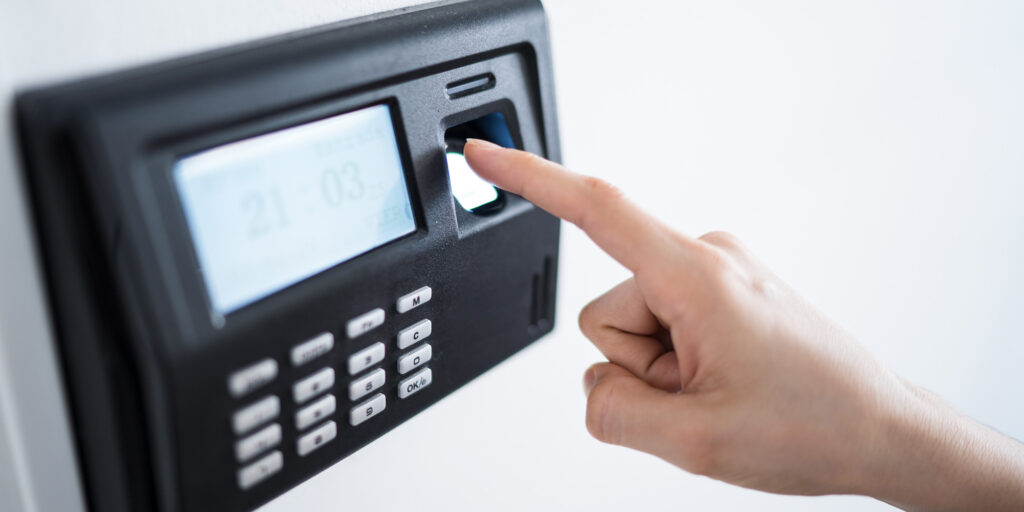
Should you buy a biometric time clock for your hotel?
As technology continues to push forward, you (along with many other hoteliers) may find yourself wondering if you should upgrade your timekeeping devices to biometric time clocks. But is this the right investment for your particular hotel?
What is a biometric time clock?
First of all, a biometric time clock is a timekeeping device that controls an employee’s ability to clock in and out from work using some personal characteristic (e.g. a fingerprint).
Here are five questions to help you decide if you should purchase a biometric time clock:
1. How likely is your workforce to buddy punch?
Biometric time clocks are ultimately all about discouraging buddy punching (employees clocking in for other employees who are not present), so how much are you concerned about buddy punching in your hotel? Our recommendations are as follows:
-If you have a long term workforce who are very stable and you have a high degree of trust, you probably don’t need a biometric time clock.
-If you have at least a portion of your workforce that is more transient (comes and goes), then you probably would benefit from a biometric time clock.
2. How important is it for you to have more intensive controls?
A lot of the benefit of a biometric time clock is the peace of mind of knowing that you’re putting in an additional control to fight payroll fraud.
-If controls are important to you because you are a fiduciary managing on behalf of others, biometric time clocks might be a good idea regardless of the size of the hotel.
-If you have owners or senior managers at the property most of the time, it might not be as important to have biometric time clocks.
3. Are you prepared for an extra step in on-boarding employees to enroll them in the biometric clock?
Each employee needs to be enrolled into your hotel’s time clock system in order to begin punching. With biometric time clocks, managers must enroll each employee at the time clock with the employee present. If you have an HR or payroll person on-site, this might not be a big deal; however, if this is not the case, realize you’ll be adding a step to every new hire for your local operations managers.
4. How will your employees react to biometrics being used?
Some employees don’t like biometric time clocks, as they see it as an invasion of their personal privacy. They may not like the idea of the clock storing their personal information. A few years ago, New York City famously experienced a big initial backlash when city employees were required to clock in and out using a biometric device. The city reported significant reductions in payroll fraud from the initiative, but the initiative was very unpopular among employees.
Hotel managers should be prepared to communicate with their employees about how the time clock devices work. For example, the fingerprint time clocks that Hotel Effectiveness offers do not store a complete fingerprint image. They only record certain landmarks on the person’s fingerprints. An employee may be more accepting if they understand that it would be impossible to re-create a complete fingerprint with the data in the system.
5. Do you have the budget for a more expensive time clock?
You should expect to pay anywhere from several hundred dollars to a few thousand dollars for a reliable biometric time clock, so if your hotel is very budget or cash flow constrained, you might want to stick with a non-biometric time clock.
What are the different types of biometric time clocks available?
Fingerprint Clocks
Fingerprint time clocks are the most affordable and common type of biometric time clocks. They allow staff members to clock in and out using exactly what you would expect – their fingerprint. Typically, employees press a button for either clocking in or out, then place the tip of their index finger on the reader. Once their print is recognized, their punch is confirmed.
Since no two people have the same fingerprints, the time clock knows precisely who is clocking in or out, so there is no need for employees to enter pin numbers or any other unique identifiers.
However, it is important to note employees who perform a significant amount of labor with their hands (ie. housekeepers, housemen, and maintenance employees) may have difficulty using this time clock, as their fingerprints tend to become worn and unrecognizable at times. Our experience is that often as much as 10% of a workforce in a hotel may experience at least occasional struggles with using a fingerprint time clock. Make sure the clock includes an override option where you can allow only certain trusted employees to use a PIN or badge to clock in if their fingerprint quality is poor.
Hand Geometry Clocks
Hand geometry clocks measure the unique shape and size of staff members’ hands. This includes length, width, thickness and surface area of the fingers and palm. The hand geometry clock tends to be the most reliable form of biometric device, as it does not consider fingerprints, rather hand and finger size. It is rare for an employee to not be able to use the clock. This makes them ideal for workforces that have a large portion of employees who perform manual labor.
However, hand geometry clock suffer from two disadvantages. They tend to be bulky to mount since they are significantly larger than a fingerprint clock. They also are the most expensive biometric time clock. It’s not unusual to pay thousands of dollars for a hand geometry clock.
Facial Recognition Clocks
Facial recognition clocks are the newest type of biometric time clocks. These clocks digitize characteristics of the face to make a ‘face print.’ Typically, they measure the distance between a person’s eyes, the width the nose, and similar features. Many people are familiar with this concept from social media sites that identify people in a picture by comparing it with an image from the person’s profile.
From our experience, facial recognition time clocks are overall pretty good but also highly variable. This technology is advancing rapidly right now but the time clocks on the market are typically using older versions of facial recognition readers and software. Our general advice is hold off on investing a lot of money in facial recognition time clocks. We expect this technology to mature a lot, so we’d suggest letting the time clock manufacturers integrate the more recent technology into their devices before pursuing this option.
If you do decide to pursue a facial recognition time clock, you need to be very deliberate in how you mount the time clock on the wall. Our experience is that these clocks can be frustrating or harder to use for employees who are taller or shorter than average because they literally might be squatting down or on their toes to try to scan their face. You’ll also need to be aware that lighting in the area of the time clock can impact how well it works. Lighting that is too dim or too bright can cause issues with the facial reader.
You should expect to pay about 25% more for a facial recognition time clock as compared with a fingerprint time clock.







